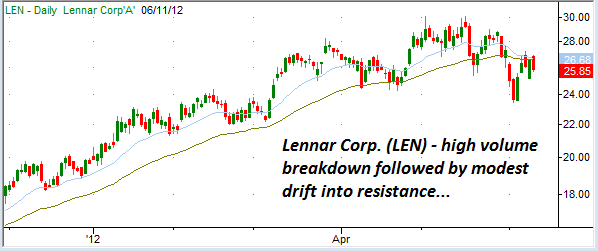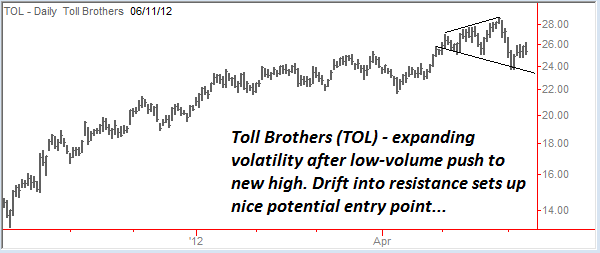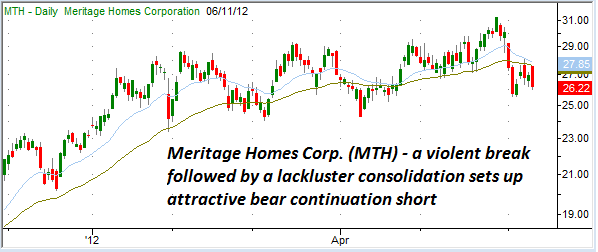Don’t look now, but US equities are just a couple of percentage points from going negative on the year.
The S&P 500 (which was up as much as 12.8% in early April) has given back nearly all of its 2012 gains, and considering the increasing volatility, it won’t take much to push the benchmark average into the red.
From a trading perspective, the accelerated decline in early June initially left a wide number of sectors extended to the downside. Stocks in these groups need a good bit of consolidation or drift before they can become good reward-to-risk short candidates.
But the homebuilder sector offers a number of much more timely short setups. The group has just begun to break down, so most of the key stocks have not fallen to the point where they are oversold and ripe for a dead-cat bounce.
Moreover, institutional investors have been building exposure to the area based on a widespread perception that the business environment for homebuilders has been steadily improving. An eight-month rally for the group has resulted in premium stock valuations, and chart patterns that offer plenty of space before major support levels come into play.
The entire sector looks poised for a significant break, and there are a few key stocks in the group that offer particularly good reward-to-risk short opportunities.
The Rationale Behind the Rally
Before discussing the bearish scenario for homebuilders, we need to first understand why the group has traded so well for the past eight months.
There are a few key factors that have helped to prop up the industry:
- A Goldilocks economy where economic growth is not too hot, and not too cold. This allows the Fed to keep interest rates exceedingly low, which in turn keeps pressure on mortgage rates.The combination of slow growth and low rates was just good enough to drive modest demand for residential real estate, and help soak up excess supply.
- Reluctance from the banking industry to aggressively pursue foreclosures. It has been very clear that high foreclosure levels have pressured real estate prices – causing the banks to take heavy losses on their properties.The Goldilocks environment gave the banks a bit more flexibility, and fewer foreclosures have led investors to believe that the situation is improving for homebuilders.
- A low level of housing inventory in some markets has led to the perception that all is well for the residential real estate market. As this Los Angeles Times piece states, a lack of available homes in Southern California has led to buyers making bids on properties before they are even listed…
Headline statistics and low interest rates have supported positive sentiment for homebuilders, driving stock prices for home construction stocks higher for the majority of the last three quarters.
Unfortunately (for the bulls at least) the environment isn’t quite as good as it looks. Banks may have pulled back on the number of foreclosures initiated, but that doesn’t necessarily mean that homeowners are staying current on their loans.
In fact, a temporary rebound in the housing market could be just the ticket to kick off a new round of foreclosures and distressed sales, as the banks take advantage of any rebound to offload more risk.
But let’s not get ahead of ourselves…
While foreclosure rates have declined and homebuilder stocks have been relatively strong, the residential real estate market is still in a very tedious place. A recent Reuters article outlined the difficulty in extrapolating trends from the myriad of data points covering this industry.
Mortgage rates are hitting new historic lows, but, contrary to conventional wisdom, pending home sales and mortgage applications have declined. At the same time, home prices are rising…
“2012 will be a very confusing year for consumers,” says Stan Humphries, chief economist of real estate website Zillow Inc.
With seesawing numbers, those seeking to buy or sell property are losing perspective on whether housing is on the upswing … or still waiting to hit bottom.
The May payroll report threw the bulls a curveball as the number of new jobs created last month came in well below expectations. Now that employment is no longer contributing to the “muddle through” growth environment, the Goldilocks economy is slipping toward “too cold” with the icy risk of deflation.
Now investors have to hang their hopes on another round of quantitative easing (QE3), but Bernanke’s latest comments indicate that this is somewhat of a pipe dream (at least for now).
One other important statistic is that US consumer debt levels are falling faster than at any time since the 1950s. This may seem like a positive turn of events for housing – and from a long-term perspective this statistic would argue for a more stable real estate market with healthy buyers in place.
But in the short run (through the end of this year and into 2013), a falling debt level simply indicates that consumers are deleveraging, which means they are reluctant to take on the added burden of a new home complete with a new mortgage (not to mention taxes, moving expenses etc.)
Valuations Much More Compelling (for the Bears)
A year ago, the outlook for residential real estate may have been just as gloomy, but the valuations for homebuilder stocks were much different. Sentiment for the group was poor, and investors weren’t willing to pay a premium considering the risk they were taking.
But today, homebuilders trade at much higher valuations, reflecting the rebound in sentiment.
The iShares Dow Jones US Home Construction (ITB) ETF now trades with an average price to prospective earnings of roughly 27. And considering the souring economic picture, those prospective earnings are highly suspect.
Looking at the valuations in terms of book value, the industry is trading at about 2.25 times book value which is also historically high.
During the financial crisis, it was not uncommon to see the majority of homebuilders trading for less than book value because there was absolutely no confidence in the value of the underlying real estate holdings.
Today, investors seem more than willing to not only pay for the underlying assets of these companies, but also for the prospect of improving the book value through the process of building homes and selling to new home buyers.
Even during an expansion period, it would be difficult to justify paying 2.25 times book for these capital-intensive businesses. But during a challenging economic period, that premium to book value looks particularly dangerous.
The iShares Home Construction ETF is also trading less than 10% below its 52-week high (and is up roughly 80% from the low printed in the third quarter 2011). So from both a technical AND a fundamental perspective, home construction stocks have the potential for a very large drop.
The macro picture for homebuilders as a group is certainly challenging, and we’ve isolated individual names within the group that look particularly vulnerable.
Below are some of the specific stocks we are interested in shorting: 
Lennar Corp ‘A’ (LEN)
- Builds single family attached and detached homes. With a focus on the middle class home buyer, Lennar is particularly vulnerable to souring national employment trends along with potential foreclosure supply issues.
- Lennar also invests in distressed properties with the expectation of realizing a gain as economic trends improve. Another economic dip would extend the time required for these properties to yield a profit, meanwhile taxes and upkeep make distressed property a negative carry proposition.
- The stock is trading at 1.8 times book value, and is vulnerable to a writedown of both its traditional home portfolio and the value of distressed properties.
- LEN broke a key support level at $24 early in June on high volume. A drift back up to the 50 EMA creates an attractive short entry point.

Toll Brothers (TOL)
- Toll Brothers focuses on luxury communities. Wealthy homebuyers are not as affected by national employment statistics, but are much more cognizant of financial markets. The recent decline in equity indices causes buyers in this demographic to step back and wait to see if markets will recover.
- TOL also owns and develops golf courses and country clubs. Luxury retail stocks have been trading sharply lower as affluent consumers rein in spending. This trend doesn’t bode well for TOL’s additional business lines, which rely on discretionary spending from affluent consumers.
- After hitting a new high on very light volume in late May, TOL broke down sharply with volume and volatility levels expanding rapidly. A quiet drift higher to the $26 level doesn’t do much to inspire confidence.

Meritage Homes Corp. (MTH)
- While Meritage is classified as a national homebuilder, their activities are concentrated in the Western and Southern United States – two areas that have been particularly hard hit by real estate weakness, and areas that have been relatively slow to recover.
- MTH also trades at a relatively high price to book ratio – an important metric when considering the potential for renewed write downs as the economic picture deteriorates.
- It is challenging to determine an appropriate price / earnings ratio for MTH because the company posted a loss in 2011 after recording a very small profit in 2010. Analysts have been revising 2012 and 2013 estimates lower.
- Meritage also saw a volatile stock price decline in the beginning of June, but in contrast to other homebuilders, its consolidation over the last week has been much more subdued. A new break in price would represent an attractive bear continuation setup.

Disclosure: This content is general info only, not to be taken as investment advice. Click here for disclaimer
